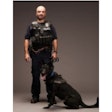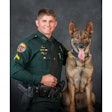The tactical medic must be able to effectively carry equipment and be able to operate in a tactical situation without hindering the rest of the team. So he or she must decide what items and tools will be carried into the field and what equipment will be left in a vehicle or in a larger kit.
In general, medics carry two sets of medical equipment. One set is carried for immediate care, typically worn in a small backpack or load-bearing vest. The second set is carried in a larger backpack or duffel bag in the support vehicle.
Here’s a guide to what gear, solutions, and tools should be in each pack.
Personal Protective Equipment (PPE)
Universal precautions against infectious diseases must be used by tactical medics. Masks, eye protection, gloves, and perhaps even gowns must be considered. The basics for protection should be carried on the medic’s person in an easily accessible location.
For example, some medics don surgical gloves underneath their shooting gloves prior to an operation so they will be ready if the need arises. Although not sterile, the surgical gloves do provide protection from body fluid-borne pathogens.
Personal Supply Module (PSM)
To reduce the equipment carried by the medic and so that the team members can help themselves, each member of the tactical unit should carry a “self help kit” with medical supplies.
A typical personal supply module is vacuum-sealed and contains supplies for basic trauma care and for IV access. Vacuum sealing these contents provides protection from the elements. It also cuts down greatly on bulk, but adds some weight.
Basic Medical Module (BMM)
In addition to a PSM, a Basic Medical Module (BMM) should be carried by team medics. Since every team member on a tactical unit should have at least basic EMT certification, a BMM could be used by any team member to provide initial care to a victim. The BMM should have basic splinting material and dressing material.
Basic airway tools such as nasal airways and a pocket mask should be included. A bag valve mask or more compact alternative is advisable in the tactical environment. A simple bag-valve mask alternative device (BVMAD) can be constructed out of respiratory supplies to combine a one-way valve, flexible tubing, and mouthpiece. This is the preferred ventilatory device in the tactical environment, as it allows a rescuer to provide ventilation without unnecessary bulk.
Oxygen rarely is useful in the immediate tactical environment, so leave the O2 cylinders in the support vehicle with a regular BVM that can be retrieved when necessary. An automated external defibrillator (AED) should also be carried in the support vehicle. A small collapsible litter for extrication of a downed person should be a part of every BMM.
Intermediate Medical Module (IMM)
Paramedics and registered nurses can use the equipment in an intermediate level module (IMM). This kit differs from the BMM, as it includes equipment and supplies suitable for advanced life support (ALS).
Under “standing orders” from a team physician, ALS-qualified medics may provide advanced cardiac life support to a victim. So an IMM is much more extensive than a BMM and contains medications, IV tubing, IV fluids, endotracheal tube, combi-tube, laryngoscope, light wand, and, if protocol allows, cricothyrotomy kit.
A cricothyrotomy kit facilitates placement of a definitive airway prior to transport. When a definitive airway is combined with the use of a BVMAD, it allows hands-free ventilation of a patient, making it possible for one or two team members to extricate the patient. If a cricothyrotomy kit is carried, the medic should be proficient in its use, as conditions in the tactical environment are difficult at best.
Many intermediate-level medics include hemostatic dressings in their trauma kits, but the benefits and potential hazards of their use are the subject of debate.
Direct pressure with a sterile dressing is the best initial approach to hemorrhage control. And pressure point compression and tourniquets are useful adjuncts to any bleeding problem. So these materials should be included in the major trauma module (MTM): a set of combine dressings, gauze, petrolatum gauze, tourniquets, and Israeli dressings.
Support Vehicle Module
Additional supplies and equipment should be stored in the support vehicle module (SVM). For example, ready supplies of consumable items should be kept in the SVM so that other modules can be restocked.
The SVM should contain equipment such as oxygen cylinders, an AED, airway adjunct devices, fiber optic scopes, nebulizers, surgical trays, chest tubes, cervical collars, backboards, peroxide, povidone-iodine, liter bags of crystalloid IV fluid, replacement filters for gas masks, and fiberglass splinting material.
For Advanced Providers
Field care is limited only by the equipment that can be transported and the training of the providers. Some of the items carried by advanced providers include:
• Central line
• Tracheotomy set
• Retrograde intubation set
• LMA
• Chest tube set
• Fiberoptic intubation set
• Blood products or blood substitutes
WMD Specialty Gear
Depending on the role of the tactical unit, chemical, biologic, radiological, or nuclear (CBRN) threats may be encountered. These incidents require tactical emergency medical care because they are large crime scenes with many casualties.
Tactical medics are much more familiar with evidence collection and preservation, and typically already have necessary security clearance to enter such an area. So until the scene is cleared, the tactical medics may be the only medical care available to victims inside.
The chemical and biologic environments are specialized depending on what agent is released. Various civilian and military protective gear and respirators or supplied air sources may need to be worn. Operating in CBRN protective gear requires extensive training in addition to regular tactical training.
Antibiotic prophylaxis with ciproflo-xacin, as well as agent detection equipment, may be carried by the medic in this case. Several biologic and chemical diagnostic kits and meters are available, but costly.
Radiological incidents would likely involve the dispersal of a radiological agent with conventional explosives, a “dirty bomb.”
Learning how to work in a radioactive hot zone produced by a dirty bomb, nuclear detonation, or atomic reactor release requires lots of additional training. But it’s not beyond the realm of tactical emergency medicine.
Finally, while chemical weapon attacks are not (yet) common occurrences for law enforcement, many officers are exposed to chemical hazards from clandestine drug labs. So it’s a good idea for tactical medics to learn how to work in chemical protection suits.
Lawrence E. Heiskell, M.D., FACEP, FAAFP, is the founder and director of the International School of Tactical Medicine in Palm Springs, Calif., as well as a member of the Police Advisory Board.
Bohdan T. Olesnicky, M.D., is the vice-chairman of the emergency department at Christ Hospital in New Jersey and a tactical physician for the Clifton (N.J.) Police Department. He is also on faculty at the International School of Tactical Medicine.
Equipping the Tactical Medic
The tactical medic must be able to effectively carry equipment and be able to operate in a tactical situation without hindering the rest of the team. So he or she must decide what items and tools will be carried into the field and what equipment will be left in a vehicle or in a larger kit.












